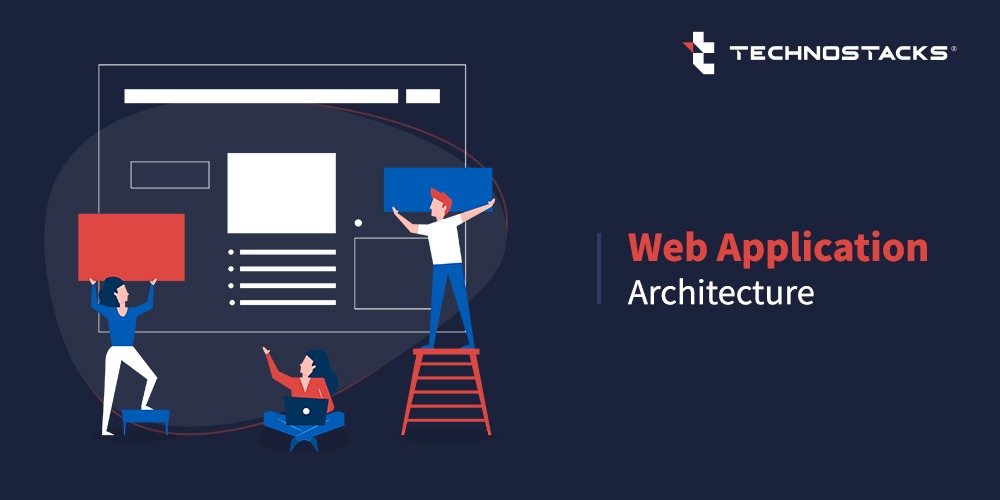Guide on Web Application Architecture
Web application architecture always plays a crucial role in setting up the foundation of business apps. It becomes necessary to consider understanding the concept characteristics and the behavior of the architecture.
This understanding ensures meeting the business needs and the goals in a hassle-free manner. That said, in this article, you would be getting the answer to what is web application architecture? You will also get access to highlights on the web application architecture layers, components, models and its types alongside the best practices for giving you enhanced results.
Our guide on Web Application Architecture suggests that the quality induced web architecture turns out to be the de facto of the good products and is always instrumental for the information and the data flow to achieve the desired business rules. That being said, it can work in the blueprint for the data and information flow while solving the business issues effectively.
Definition of web application architecture
Web application architecture refers to the pattern of the interaction between the various Web Application Components. The type of the application architecture is completely dependent on how the application will be finding distribution among the client and the server-side.
How does web application architecture work?
The web applications will have the client-side these other two programs that are always running concurrently. The code of modern web application architecture lives in the browser and keeps responding to the user input, and again the code which lives on the server responds to the HTTP request whenever you’re writing.
It is always up to the Web app developers to decide what the code on the server should be doing about what the code on the browser should do.
There will be all languages like PHP, Java, Python, JavaScript, Ruby On Rails, and C# with the server-side code. All the courts can respond to the HTTP request and always have a capability for running on the server. Certain attributes make it favorable. The client-side most popular programming languages include CSS, JavaScript, and HTML.
Apart from these, additional components like the database server will be sending the requested data to the server-side. The server always works for catching the request and sending it to the data storage for the page’s location and requesting for the data to get displayed on the browser.
Layers of Web App Architecture
There are commonly four layers of the web applications- presentation layer abbreviated as PL, data service layer abbreviated as DSL, business logic layer abbreviated as BLL, and the data access layer added as DAL.
- The presentation layer is the one that displays a user interface and always makes the user interaction more straightforward and also comes with the UI components helping in showing data for the users. They are also good enough for setting user interactions in a hassle-free manner. It can give all the required information to the client side. The primary goal is to always get the input data and the user’s request by sending them to the data service and showing the results.
- The business logic layer is responsible for considering the practices for the proper data exchange. The layer always sets definitions for the logic for the business operations as well as the rules.
- Again, the data service layer works for processing the business logic layer to the presentation layer and always guarantees data security. Besides, it can work for isolation of the business logic from the client-side. The data access layer is fit to simplify access to the data stored in the persistent storage like the binary and the XML files. The data access layer also works for managing, creating, reading updates and delete operations.
[call_to_action title=”You want to develop an Web App For your business?” subline=”Take the first step towards your business growth” button_text=”Click here to start now” utm_source=”blog+cta” utm_medium=”blog+page” utm_campaign=”web-application-architecture” theme=”red”]
Web application components
The web application components are broadly classified into two parts.
- The user interfaces components are the ones that work in the form of the part of the visual interface related to the web application and have no interaction with architecture.
That said, they are vulnerable to the restriction to the display of the web page and consist of the activity logs, dashboards configuration, settings, widgets, statistics, and notification. Overall it was for enhancing the user experience.
- Structural web components always consist of the client and the server components. These are the components that exist in the user’s browser and will be helping in the interaction with the functionality of the web applications. JavaScript, HTML, CSS are the commonly used entities for building the components.
On the other side, the server components bifurcate into the web app server handling the business logic and database server for storing the data. PHP, Python, Java, node.js, .NET, and Ruby on Rails are some of the famous frameworks used to create the server components.
Models of Web Applications
For the right web architecture of the components, always should consider the future with applications performance.
One web server with the database is the simplest and the riskiest model where there is a single database in the form of the part of the web apps only server. In case the server goes down, the web will be going down as well.
The 2 + web browsers with one database are the idea where the web servers don’t need to store any data. Even when it is getting the information from the client, the web server will be processing and writing the data to the database and forgetting about it. When there are at least two webs there will be a reduced failure risk. If one of the webs is going down, then another is going to take over that immediately. However, one database will always be associated with the performance risk. The risk is in the form that if it crashes, then the entire system is going to crash.
Let’s now discuss the 2 + web service that serves with the two-plus databases. This model will be considered risk-proof because neither the webs nor the databases have their single points of failure. When the web application development project continues, and more than 5 services of the databases are there, the frameworks will be working to store the identical data on each of the database machines.
Again there is an alternative to evenly distribute the data between the databases. Get the advantage of the storage space-saving. The option turns out to be a risky one for becoming vulnerable to unavailability in the event of a database crash.
Microservices and serverless is another entity. The three models that we have mentioned above are always referred to as monolithic due to the stability and the rigid nature of web browsers. On the other hand, the microservices, AWS serverless architecture, have found the information for the simple reason of bringing simplicity to the web browsers.
By simplifying the upgrades and scaling in both the models will get the smaller components like the services and the functions. Each of these smaller components always considers the separate container and finds treatment independently that can be easier for modifying or scaling.
Types of Web Application Architecture
It is always a good practice to consider selecting the most appropriate architecture while considering certain aspects. Always pay attention to the app logic, functionalities, features, and business requirements. Here is a division of web application architecture.
- Single page application architecture
The introduction was for overcoming the traditional limitations to achieve smooth performance. Besides, you can get an innovative and interactive user experience. Instead of just loading the page, you will be getting the single page application architecture and a web page and then reloading the requested data on the same page with dynamically updated content.The rest of the webpage, however, remains untouched. This finds development on the client-side utilizing the JavaScript framework in the form of the entire logic getting shifted to the front end. - Microservice architecture
Microservice architecture is also becoming the perfect alternative to service-oriented architecture as well as monolithic architecture. These services are always loosely coupled for the development, testing, maintenance, and deployment.These services can also ensure communication with the other server. It does so with the help of the API for solving complex business problems. - Serverless architectureThe serverless architecture is good enough in terms of design patterns. The applications are always run without the manual intervention on the servers finding management by the third-party cloud services. Some of these components are like Amazon and Microsoft. It always gives you more focus on the quality of the product while lessening the complexity to make it highly scalable and reliable.
- Progressive web applicationsGoogle has also introduced progressive web applications according to the 2015 update that can ensure the development of the apps that will be offering that native functionality with enhanced reliability and capabilities. Besides, you can also find the convenience in terms of the easy installation.
[call_to_action title=”Want to Know the Cost of App Development?” subline=”Take the first step towards your business growth” button_text=”Let’s start now” utm_source=”blog+cta” utm_medium=”blog+page” utm_campaign=”web-application-architecture” theme=”red”]
Web Application Architecture Best Practices & Tools
The designing of the architecture is always the first step, but you will always have to consider certain practices that can ensure good results for better success. For the avoidance of problematic circumstances, it’s always good to follow the practices.
- Make sure about ensuring the system flexibility and efficiency
- Pay attention to your component reusability
- Always pay attention to high scalability stability as well as reliability.
- Make sure the structure of the code is a refined one
- Pay attention to easy bug detection and utilize the A/B testing. For that, also pay attention to the utilization of the security standards.
- Ensure sectioning to collect the user feedback and the tools that will give you the best experience.
Some of the tools are as follows:
- IDE tools: some of the most famous are Webstorm, NetBeans, AWS cloud9, ensuring working with productivity enhancement. Eighty percent of software developers are relying on these tools.
- UX builder tools: Figma, Sketch are some of the commonly used tools that can improve the user experience. Standard UI toolkit reduced project development and testing time by 33 percent.
- Frameworks and libraries: React, Angular, Express are some popular frameworks working to deliver quality and product. More than 5 million developers in around 200 countries use frameworks for the projects.
- Integration tools: Multisoft, Jitterbit, automat.io are some of the famous tools that can ensure the delivery of a seamless, engaging and unified experience.
Key Takeaways
Web application architecture is always working in the form of the backbone of an application. There are chances of miscalculations and inaccuracy at every stage that turn out to be quite costly.
So always pay attention to the strategies and the tools you will have to use to eradicate the issues related to the web application architecture.
If you want to build a successful web application or have any feedback regarding the article then you contact us or comment below.








